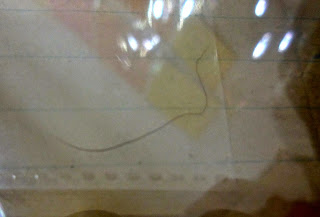I met Mr. Boogers on a September night in the early 1990s near Avenue A. He was sitting in his van, a rickety contraption with "Mr. Boogers" hand-painted slapdash on the sides and a blow-up sex doll lounging in a chaise strapped to the roof.
 Boogermobile, 2nd and 8th, early 1990s
Boogermobile, 2nd and 8th, early 1990s
With the van's side door wide open, Mr. Boogers sat on the edge, inserting batteries into light-up roses and filling Weepy the Wee-Wee dolls with water. He invited me to give him a hand. Being young and seeking adventure, I climbed into the van, onto the one chair not covered with cheap souvenirs, most of them of the adult variety--pens in the shape of penises, novelty cigarette lighters from which sprang plastic penises instead of flames.
Boogers instructed me to fill a bag with the "dick lighters" and then put batteries into flashing yo-yos. A homeless man joined us. I think his name was Jim. Boogers told him to fill the "piss dolls." Jim figured out a special method for doing so. He'd fill his mouth with water and then spit it into the doll's base through a plastic straw. A funnel would have helped, but Mr. Boogers didn't have a funnel.

When we had finished prepping,
Mr. Boogers invited me to stay with him and Jim, to work the San Gennaro Feast, selling the novelties on the street. He said he would pay me. I agreed--some extra money would come in handy. In the van, Boogers talked about his life selling novelties at race tracks, street fairs, and other such events. Jim talked about his wife and kids in Pennsylvania, and about his alcohol problem that he was trying to get under control.
On Mulberry Street, Mr. Boogers divided the merchandise. Jim got a handful of light-up roses and the bag of dick lighters. I got the yo-yos. Mr. Boogers took the piss dolls. In the sea of feast-goers, we each found a corner and got to work. I yo-yo'd clumsily, the little disks wobbling and flashing neon colors through the lights and fried-food smell of the feast. I probably called out something like "Yo-yo's here, getcha yo-yo's here." Somehow, I managed to sell quite a few. I felt proud of my yo-yo selling skills. It was all going so well.
Then Mr. Boogers came over, panicked and angry. He said, "Where the hell is Jim?"
I looked for the tall man and his bouquet of glowing red roses, but couldn't see them anywhere.
"Find the bastard," Mr. Boogers said. "He's got all my dick lighters!"
We searched the feast endlessly. I followed Mr. Boogers as he plunged through the crowds, keeping my eye out for glowing roses. After too long of this, I was tired, frustrated, and ready to go home. So was Boogers. We never found Jim. He'd taken off with the merch--a dozen or more plastic roses and a bag full of joke penises.
 Mr. Boogers by Bob Arihood
Mr. Boogers by Bob Arihood
Boogers and I climbed back into the van. I gave him the yo-yo's and the money I had earned. He raved angrily about how he should never trust a drunk, about the money he had lost. I felt implicated somehow, and chastised, as if I'd been the thief. I couldn't bring myself to ask him for any pay and I knew I wasn't going to get it anyway. Still, I wanted something for my trouble. So I stole from him, too.
On the seat I found a keychain featuring a copulating couple, the kind where you pull a lever and their pelvises smash together.
I closed my hand around it and slipped it into my pocket just before Boogers dropped me back on Avenue A where he'd found me.
That was the last I ever saw of Mr. Boogers. I don't know what happened to the keychain. I kept it for years, and then it vanished, too.












































